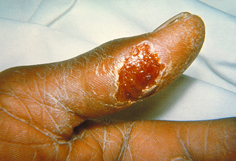How infectious diseases are spread and simple and practical advice for preventing the spread of infection in the home and community
Tularaemia - including symptoms, treatment and prevention
Tularaemia is caused by infection with a bacterium called Francisella tularensis. Tularaemia occurs in North America, Europe and Asia. A few cases have been acquired in Australia.
Tularaemia is mainly a disease of animals such as rabbits, squirrels, birds, sheep, cats and dogs.
Epidemics can occur.
Tularaemia is a notifiable condition1.
How tularaemia is spread
People may develop tularaemia by:
- being bitten by biting or blood-sucking insects (such as some types of ticks, flies and mosquitoes)
- having contact with infected animals
- consuming F. tularensis contaminated food or drink
- breathing in F. tularensis contaminated air.
F. tularensis is a potential bioterrorism agent.
Signs and symptoms of tularaemia
 The signs and symptoms depend on the site of entry of F. tularensis and other factors and may include:
The signs and symptoms depend on the site of entry of F. tularensis and other factors and may include:
- an ulcer at the bite site with painful and swollen draining lymph glands (usually if exposed through the skin) (see image)
- painful throat, painful and swollen lymph glands in the neck, nausea, vomiting, diarrhoea, and abdominal pain (usually if exposed through eating, drinking or oral contamination from the hands)
- painful conjunctivitis(usually if exposed through the eye).
Other symptoms of tularaemia may include:
- painful and swollen lymph glands in the neck
- fever and chills
- muscle and joint aches
- headache
- cough, shortness of breath, and chest pain
- rash.
Complications can occur including meningitis (inflammation of the lining of the brain and spinal cord), septic shock and renal failure.
Diagnosis of tularaemia
Diagnosis is usually made by a series of blood tests. The bacteria may sometimes be grown from specimens such as a skin swab, sputum, or lymph gland sample.
Incubation period
(time between becoming infected and developing symptoms)
2 to 10 days
Infectious period
(time during which an infected person can infect others)
Person to person spread is rare or non-existent.
Treatment for tularaemia
Tularaemia usually responds to treatment with appropriate antibiotics.
Surgical drainage of lymph nodes may be needed.
Prevention of tularaemia
- Exclusion from childcare, preschool, school and work is not necessary.
- When travelling overseas to areas where tularaemia occurs:
- Avoid being bitten by biting or blood-sucking insects by wearing appropriate clothing and applying insect repellent, following the manufacturer’s instructions. See Mozzies Suck for more information.
- Avoid contact with untreated water where infection is common in wild animals.
- Do not drink untreated water where infection is common in wild animals.
- Wear gloves when handling wild animals (such as rabbits).
- Ensure any meat eaten is completely cooked.
Useful links
- Protecting yourself and your health whilst travelling overseas
- Mozzies Suck
- When you have a notifiable condition
1 - In South Australia the law requires doctors and laboratories to report some infections or diseases to SA Health. These infections or diseases are commonly referred to as 'notifiable conditions'.
Image - Courtesy of Public Health Image Library (PHIL), Department of Health and Human Services, Centers for Disease Control and Prevention (CDC-USA)